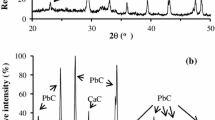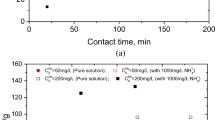Abstract
Laboratory column studies were used to predict the effect on the leachability of lead when using fly ash or a fly ash/sludge mixture as a cover for a lead tailings site. A high pH fly ash cover produced a leachate with a pH 12. This was sufficiently high to allow for the formation of lead hydroxide complexes which are slightly soluble. Therefore, the leachate had an average lead concentration of about 5 mg L-1, while the pH in the leachate from the column with only tailings was 7.8 and a lead concentration below the detection limit (≤0.1 mg L-1). The fly ash cover changed the availability of the remaining lead, making it less available. Rainfall rate did not affect the fly ash cover, but did have an effect on the fly ash/sludge cover.
Similar content being viewed by others
References
Brown, J. R. and Rodriguez, R. R.: 1983, ‘Soil Testing inMissouri’, Missouri Cooperative Extension Service. University of Missouri, Columbia, Missouri.
Buchauer, M. J.: 1973, ‘Contamination of Soil andVegetation Near a Zinc Smelter by Zinc, Cadmium, Copper and Lead’, Env. Sci. and Tech. 7(2), 131–135.
Chaney, R. L. and Ryan, J. A.: 1994, ‘State-of-the-art in Evaluating the Risks of As, Cd, and Pb in Urban Soils for Plants, Animals and Humans’, Proc. Conf. Criteria for Decision Finding in Soil Protection: Evaluation of As, Pb and Cd in Contaminated Soils ( Oct. 9–11, 1991; Branschweig FRG).
Clevenger, T. E. and Rao, D.: 1996, ‘Mobility of Lead in Mine Tailings Due to Landfill Leachate’, Water, Air and Soil Pollut. 91, 197–207.
Clevenger, T. E., Saiwan, C. and Koirtyohann, S. R.: 1991, ‘Lead Speciation of Particles on Air Filters Collected in the Vicinity of a Lead Smelter’, Environ. Sci. and Tech. 25(6), 1127–1133.
Czarneski, J. M.: 1985, Bull. Enviorn. Contam. Toxicol. 34, 736.
Goodman, G. T. and Gemmell, R. P.: 1978, The ‘Maintenance of Grassland on Smelter Wastes in the Lower Swansea Valley (England). II. Copper Smelter Waste’, J. Appl. Ecol. 15, 875–883.
Hansen, J. E. and Mitchell, J. E.: 1978, ‘The Role of Terraces and Soil Amendments in Revegetating Steep, Smelter-Affected Land’, Rec. Rev. 1, 103–112.
Harwood, J. R.: 1984, ‘Assessment of Leaching from Lead Mine Tailings’, Ph.D. dissertation. University of Missouri, Columbia, Missouri.
Harwood, J. R., Koirtyohann, S. R. and Schmitt, C. J.: 1987, ‘Effects of Cover Materials on Leaching of Constituents from Dolomitic Lead Mine Tailings’, Water, Air and Soil Pollut. 34, 31–43.
Oyler, J. A.: 1989, ‘Remediation of Metals-Contaminated Site Near a Smelter Using Sludge/Fly Ash Amendments: Herbaceous Species’, Proceedings Trace Substances in Environmental Health XXII, D.D. Hemphill, Editor, pp. 306–320.
Rao, D.: 1991, ‘Mobility of Lead in MiningWaste Due to Landfill Leachate’, M.S. Thesis. University of Missouri, Columbia, Missouri.
Schmitt, C. J., Dwyer, F. S. and Finger, S. E.: 1984, Can. J. Fish. Aquat. Sci. 41, 1030.
Author information
Authors and Affiliations
Rights and permissions
About this article
Cite this article
Clevenger, T.E., Dave, S. Leachability of Lead from Lead Tailings. Water, Air, & Soil Pollution 106, 379–387 (1998). https://doi.org/10.1023/A:1005044723271
Issue Date:
DOI: https://doi.org/10.1023/A:1005044723271




